
MASTERING WATERFALL PHOTOGRAPHYMastering the art of photographing falling water requires using the right equipment along with proper techniques. Although it may seem like an art best reserved for the professionals, photographing waterfalls can actually be quite simple to learn, with drastic improvement happening quickly. After shooting tens of thousands of waterfalls in just about every weather condition, I have come up with some straightforward guidelines for beginner and advanced waterfall photographers alike. In addition to this page, I have also created a list of 100 waterfall photography tips. 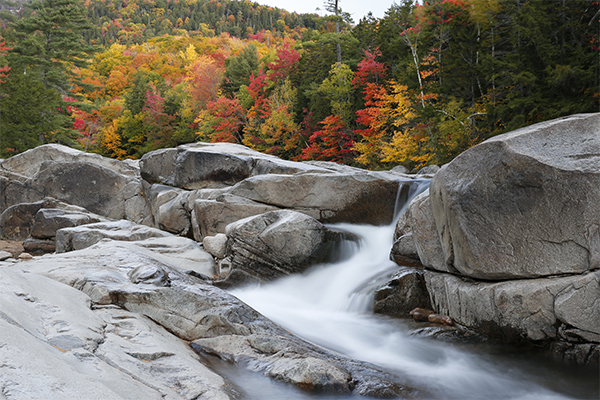 Lower Falls, New Hampshire CAMERAS FOR WATERFALL PHOTOGRAPHYThe first and obvious piece of equipment you are going to need to shoot waterfalls well is a quality camera. You've got five camera options to choose from:
Point-and-shoot cameras are inexpensive, with most models landing in the $150-$300 price range. However, only the most expensive models allow any sort of manual control in terms of ISO, aperture and shutter-speed adjustments (these important concepts are discussed later). Medium-format and large-format cameras are prohibitively expensive, although they can take absolutely gorgeous high-resolution photographs. They are also quite heavy, making hiking and backpacking much more of a challenge as compared to other camera types. Although a few professional landscape photographers still use film cameras, especially with slide/transparency film, digital photography is simply easier, more efficient, and much cheaper to use. The best slide/transparency films run $8-10 per roll these days, and then it's another $10 or so to develop the 24 or 36-slide roll. Of these five types of camera options, a DSLR or mirrorless digital camera is the clear winner for the vast majority of professional landscape photographers. DSLRs and mirrorless cameras allow you the flexibility to manually change important settings like ISO, shutter speed, and aperture. DSLRs and mirrorless cameras also have interchangeable lenses, some of which allow you take wider-angle shots than you could with any other camera type. RECOMMENDED DSLR CAMERASHere are some recommended DSLR cameras that are currently on the market: Entry-Level / Budget DSLRs These cameras are all a huge step up from point-and-shoot cameras in terms of photographic potential and image quality. Entry-level DSLR cameras typically have a 'crop sensor', which means that lenses placed on these cameras will have an effective focal range that is longer than what is listed on the lens (for example, a 16-35mm lens on a 1.6x crop-sensor camera acts like a 25.6-56mm lens. CANON EOS Rebel SL1 CANON EOS Rebel T5 NIKON D5500 NIKON D3300 Professional-Level DSLRs Professional-level DSLR cameras will likely be prohibitively expensive for many readers of this website, but I include them here for those who decide they are willing and able to invest in the best equipment to take their photography to a higher level. Most of these cameras have "full frame" camera sensors, which means that lenses placed on these cameras will have an effective focal range that is exactly what is listed on the lens itself. What this typically means is that professional DSLR cameras are capable of taking wider-angle shots than entry level DSLR cameras can with their crop sensors. CANON EOS 5D MARK III CANON EOS 5D MARK IV CANON EOS 7D II CANON EOS 6D NIKON D500 NIKON D810 SONY A7R II 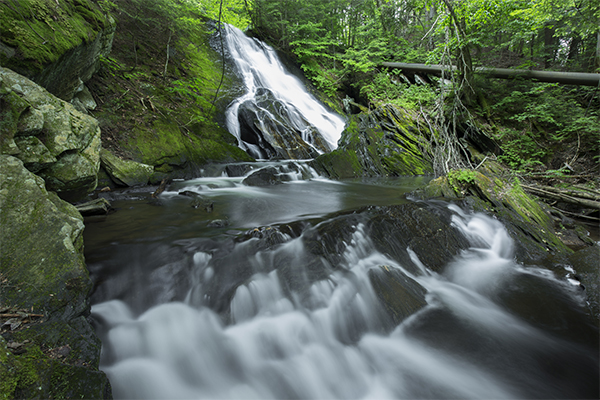 Thundering Brook Falls, Vermont LENSES FOR WATERFALL PHOTOGRAPHYLenses come in two formats: they will either have a fixed/prime focal range or they will zoom across a focal range.
Lenses come in a variety of different focal ranges:
Many waterfalls are located in gorges and narrow ravines, where a a wide angle lens will really came in handy to capture the entire scene. Wide-angle lenses such as the Canon 16-35mm L f/4.0 or the Nikon 17-35MM f/2.8D IF-ED are perfect for this task. Wide-angle zoom lens aren't always the solution. A telephoto or long telephoto zoom lens (such as the Canon EF 70-300mm f/4-5.6 IS USM) can be helpful to capture waterfalls located far off in the distance, such as when you see water cascading off a distant rock face. Wide-angle and standard-zoom lenses that are recommended for waterfall photography can range in price from very cheap ($100) to absurdly expensive ($2,500 or more). Canon, Nikon, Sony, Sigma, Tokkina, and other lens companies offer lenses of various quality and various degrees of toughness/resistance to weather and abuse. The professional-level lenses of these manufacturers are typically "faster" (meaning they have a wider aperture, like f/2.8 or even wider (i.e. f/1.2) in some instances), sharper (especially in the corners), and they produce better quality images overall. However, it is often hard for folks to justify the huge increase in price versus the inexpensive lenses. However, for the highest quality photographs, the expensive professional-level lenses are usually well worth the cost. Before buying a lens, make sure that it is actually compatible with your camera. Canon lenses can only work with Canon cameras, and Nikon lenses can only work with Nikon cameras (although there are some after-market converters). There are a lot of third-party companies that sell lenses that will work with your camera, but always do your research on the quality and build of these lenses before purchasing them. Sigma and Tokkina are two lens companies with good reputations. When shooting with a Canon camera, take note that EF-S model Canon lenses will only work with select entry-level Canon DSLR models. A lot of photographers will rent lenses in order to test lenses before they invest in them. Some popular camera and lens rental companies include lensrentals.com and borrowlenses.com. Renting from one of these shops can be a great way to try a lens before you make a major investment, especially on the professional-level quality lenses. If you do rent a lens or camera, you will be offered the opportunity to purchase damage-waiver insurance. This can be a good idea, especially if the lens and/or camera is an expensive one. Before you purchase insurance, take note that most damage-waiver insurance programs do NOT cover water damage. Shooting around waterfalls can be slippery and wet, and the risk of damaging a rented lens or camera with a fall or from the spray of water is not something you want to ignore (we once learned this the hard way and had to pay $300 to replace the front element of a lens that I scratched). I currently use several of Canon's professional-level "L" lenses for the waterfall shots in the guidebook and on this website, including the wonderful wide-angle Canon 16-35mm f/4.0L and the 'workhorse' standard-zoom Canon 24-70mm f/2.8L. I cannot recommend these two lenses enough. RECOMMENDED LENSES FOR WATERFALL PHOTOGRAPHYIn my opinion, the lenses below are many of the finest DSLR lenses that are currently on the market that will perform well for you in terms of waterfall photography. Just like the professional cameras I listed above, these lenses will likely be prohibitively expensive for many readers of this site. Again, I include them here for those that are willing and able to take their photography to the next level. CANON EF 16-35MM f/2.8L II USM CANON EF 16-35MM f/4L USM CANON EF 24-70MM f/2.8L II USM CANON 24-105MM f/4L IS USM CANON EF 24MM f/1.4L II USM NIKON AF-S 14-24MM f/2.8G ED NIKON 17-35MM f/2.8D IF-ED NIKON 24-70MM f/2.8G ED NIKON 24MM f/1.4G ED 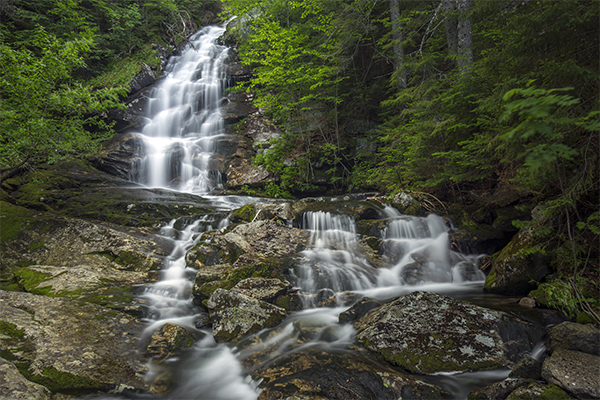 Beaver Brook Cascades, Mt. Moosilauke, New Hampshire TRIPODSOne of the best tips I can offer an aspiring waterfall photographer is to always carry and use a quality tripod. I use a tripod for 100% of my waterfall shots and about 90% of all my other landscape photography shots. A quality tripod will:
For cameras and/or lenses that have 'image stabilization' or 'vibration reduction' features (i.e. IS or VR), the longest shutter speed you should use while shooting hand-held is typically one times the focal length of the lens (for example, if you have a 35mm lens with imagine stabilization, you should use a tripod if your shuttle speed is longer than 1/35 of a second). For cameras and/or lenses that do not have 'image stabilization' or 'vibration reduction' features, the longest shutter speed I recommend without using a tripod is two times the focal length of the lens (i.e. 1/60th of a second for a 30mm focal length). A tripod will allow you to use whatever shutter speed you desire. For years, I used the Mefoto A1350Q1K Roadtrip Travel Tripod for all of my waterfall, hiking, and travel photography. This is a mid-level, mid-quality tripod. It is a bit heavy, but it folds up really nicely/small and it is sturdy enough to hold professional DSLRs and most lenses. This tripod typically will not budge when you are using it in the middle of a river or stream like some of the cheaper, lighter-weight tripods will from the force of the moving water. It was not uncommon for me to take this tripod on extended backpacking trips despite its obvious bulk and weight. If you want an inexpensive tripod, something like the Vista Explorer 60-Inch Lightweight Tripod will work fairly well. Just be aware that these types of inexpensive tripods are not nearly as rugged and will likely cause some blurring if you put them in rivers with moderate or strong currents. If you want to buy the best tripods ever made, check out the carbon fiber tripods of Really Right Stuff. A tripod and ball head from this company will cost you $1000-$1500, but many professional landscape photographers swear by them. I went on a professional landscape photographers tour in 2016 and all the other photographers were using tripods from this company. I finally folded to temptation and purchased one of these tripods in 2016. It's amazing and I have no regrets. 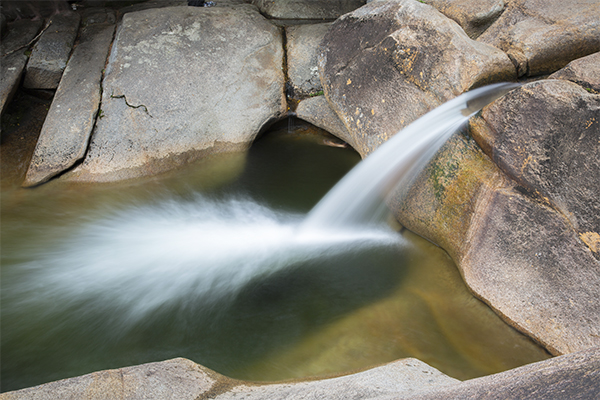 Jackson Falls, New Hampshire SHOOTING IN 'RAW' MODEMost DSLR, mirrorless, and high-end point-and-shoot cameras provide the ability to shoot in 'RAW' mode. RAW mode simply means that the camera makes no edits to the photographs you are taking. This contrasts with JPEG files, which is a format that asks the camera to make photograph quality assumptions and also to reduce file size. Some cameras will let you shoot in 'RAW + JPEG' mode. Shooting in this mode will actually save two files every time you take a shot: one in JPEG and one in RAW. Before I begin making some strong arguments on why you should always shoot waterfalls in RAW mode (or RAW+JPEG mode) can I try to convince you to just take my word for it? The benefits of shooting in RAW mode and working with RAW files are as follows:
Shooting RAW files does have a few downsides, but none of these should prevent you from shooting in some sort of RAW mode. The downsides of shooting in a RAW mode are:
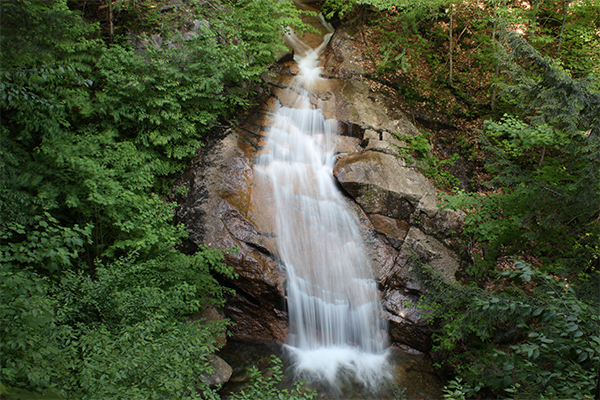 Liberty Cascade, New Hampshire SHUTTER SPEEDS FOR WATERFALL PHOTOGRAPHYLong shutter speeds are essential to create the soft “angel-hair” or “silky” look so common to waterfall photographs. Generally, speeds of 1/15 second or longer (i.e. 1/2 second, 1 second, 2 seconds, etc.) will blur the water to create this artistic effect. Long shutter speeds are also essential if you are photographing in deep gorges or chasms, where, even on the sunniest days, the area around the falls receives little light. Shutter speed must also be longer if you are shooting at or around sunrise or sunset since scenes will naturally be darker than they are during the height of the day. Long shutter speeds are not always the top choice for shooting waterfalls, though. With the traditional block type waterfalls, I suggest using 'shorter' or 'faster' shutter speeds (such as 1/45 second or 1/60 second), Longer shutter speeds on 'block' waterfalls often create a portrait of pure white water that lacks fine detail. You will find that long shutter speeds work much better for thin plunges, horsetails, or other low or moderate water-level waterfalls. Most of the photographs in the guidebook, New England Waterfalls: A Guide to More Than 400 Cascades & Waterfalls, were taken at shutter speeds between 1/15th of a second and 2 seconds. My favorite shutter speeds are usually in the realm of 1/2 to 1 second long, but each waterfall scene is different. Most advanced point-and-shoot cameras and DSLRs will have a "shutter speed priority" mode that allows you to choose a shutter speed, and the camera will automatically select some of the other shooting options (aperture, ISO film speed, etc.). This mode can be useful, but many photographers enjoy using full manual control. Full manual control allows you to also play around with aperture, shutter speed and ISO film speed at the same time. Shutter speeds can also be lengthened (i.e. from 1 second to 2 seconds) significantly through the use of neutral density filters or circular polarizers. Filters are discussed later on this page. As a reminder, you are absolutely going to want a tripod if you are shooting with a long shutter speed. If you want to get the most out of the concept of shutter speed, you also absolutely need to understand the concept of 'aperture'. Keep reading... 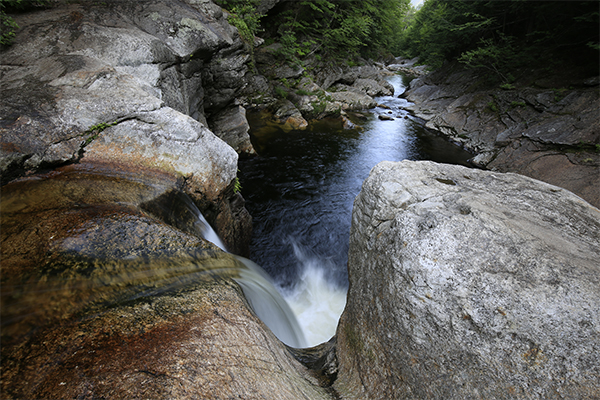 Frenchmen's Hole, Maine APERTURE FOR WATERFALL PHOTOGRAPHYEqually as important as shutter speed is the concept of 'aperture'. Aperture refers to how much of the lens is 'opened' when you are taking a photograph. A small/narrow aperture (such as f/11, f/13, or f/16) is helpful if you want to capture an entire waterfall scene, including the wildflowers, trees, rocks, and any person subjects in or around the falling water. In other words, a small/narrow aperture will allow you to include more of the foreground and background than a large/wide aperture. A large/wide aperture (such as f/3.5 or f/4.6) is infrequently used for waterfall photography because you typically want to include a lot of the foreground and background in your photograph. A small/narrow aperture like f/13 will do this more successfully. Try experimenting with apertures between f/8 and f/16. Apertures of f/11 or f/13, for example, should capture everything in focus for most shots, from a boulder a short distance in front of your feet to the trees and leaves that frame the waterfall. If you are situated very close to foreground objects, you can also try to go narrower, such as f/20 or f/22. However, take note that an (often unwanted) phenomenon called diffraction gets progressively more common beyond f/13 or f/16 on most lenses. Many photographers make a mistake of trying to focus on the shutter speed alone; do not forget to take aperture into account when composing pictures. Be aware that as you 'widen' the aperture (from f/13 to f/11, for example), you are lengthening the shutter speed (from 1/15 to 1/30, for example), which allows in more light to the photograph. Remember that you will want at least 1/15 of a second for a shutter speed in order to obtain that silky-smooth waterfall look (1/2 or even 1 or more seconds is often even better). Some advanced point-and-shoot digital cameras have a smaller range of aperture that you can select from. For example, the Canon S120 is my secondary/backup camera, and it has an aperture range of f/1.8 to f/5.7. With a camera like this, I suggest experimenting with apertures between f/3.5 and f/4.5. The point is this: aperture of f/3.5 on one camera may not be equivalent to aperture of f/3.5 on another camera. Most advanced point-and-shoot cameras and DSLRs will have a "aperture priority" mode that allows you to choose a aperture, and the camera will automatically select some of the other shooting options (shutter speed, ISO film speed, etc.). I prefer this mode over using full manual control, but other landscape photographers feel differently. Full manual control allows you to also play around with shutter speed at the same time. It will take a fair amount of trial and error to become familiar with the aperture to shutter speed relationship. 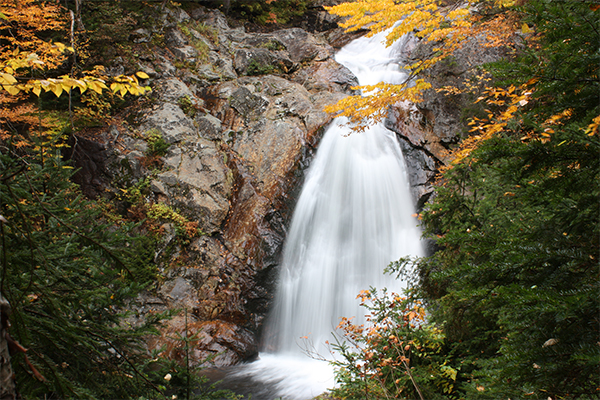 Dry River Falls, New Hampshire FILM SPEED FOR WATERFALL PHOTOGRAPHYTo create the soft, angel-hair water effect while keeping the foreground and background of the frame both focused and sharp, slow-speed film (or its digital ISO equivalent) is essential. My personal favorite slide/transparency film for waterfall photography is Fuji Velvia, which is available in ISO 50 and ISO 100 formats. The detail obtained from the this film is incredible. It also highlights blues and greens very nicely. It does not work well, however, in sunny conditions. You will want to use this film either early or late in the day, or on overcast days. Most DSLR's will allow you to select a film-speed all the way down to ISO 100 (some even go down to ISO 64 or ISO 50). As you decrease the film speed (for example, from ISO 200 to ISO 100), your camera requires more light for proper exposure. This is what will allow you to achieve the long length of shutter speed necessary to achieve desired silky-look effects. Slow-speed films are also sharper, which ultimately lends itself to higher-quality (and larger) photo enlargements. In other words, a 16x20 inch print that was taken at ISO 100 will look sharper than one taken at ISO 400. On my Canon 5D Mark III camera, I use ISO 100 for waterfall photography 99% of the time. FOCUSINGThere are two primary modes for focusing using a DSLR: manual and automatic. While you could shoot waterfalls in automatic focusing mode, manual focusing mode is what all the landscape photography professionals will use. On most DSLR cameras, setting the focus to manual is actually done on the lens itself. Most DSLR cameras and many point-and-shoot cameras will allow you to focus manually either using your viewfinder (the eyepiece) or a big LCD screen on the back of the camera. I highly recommend using the big LCD screen and then using the digital zoom features found on many DSLR cameras to zoom into the detail that you want to be tack-sharp. Once you adjust the lens to get that in focus, zoom back out and make sure the whole scene looks good and sharp to you. You can, of course, get great shots by using just the viewfinder, but I have found using the LCD screen to be a far more effective method. CIRCULAR POLARIZERSOn sunny days, even the slowest-speed films and low digital ISO settings may not be able to achieve the long shutter speeds you desire. For this, a circular polarizer filter, such as the B+W 77mm Kaesemann Circular Polarizer, can be very useful in extending the shutter speed to your desired level. These filters generally provide you with between one-and-a-half to two extra 'stops' of light. For example, if you are set up with an aperture of f/13 and a shutter speed of 1/30 second, a circular polarizer will allow you to lengthen the shutter speed to 1/10 second or 1/8 second while still using f/13 as the aperture. Circular polarizers, which were used in nearly all the photographs contained on this website, can also reduce the glare that is reflected off water, rocks and leaves. It will take some practice to get good with a circular polarizer. Rotate the polarizer while looking through your viewfinder or the LCD screen on the back of your camera. Notice what the polarizer does as you rotate it - it will either lighten or darken the scene, and it will also reduce or increase the amount of shine coming from the waterfall and the rocks around it. Take note that polarizers work best when the sun is situated 90 degrees from the shot you are trying to take. When purchasing a circular polarizer, make sure that the size of the filter will fit the 'filter thread' on your actual lens (i.e. a 77mm circular polarizer will only fit on a lens that has a 77mm filter thread). If you have two lenses with different filter threads, you can buy a cheap lens filter thread adapter so that you can use one polarizer on both lenses. Make sure to purchase a thread adapter that will grow to the thread of the filter, and not shrink to it. Thread adapters can be surprisingly inexpensive, especially if you buy from a third-party provider (you can often find great ones for under $10). Don't worry about picture quality-thread adapters typically have absolutely no effect on the final photograph. 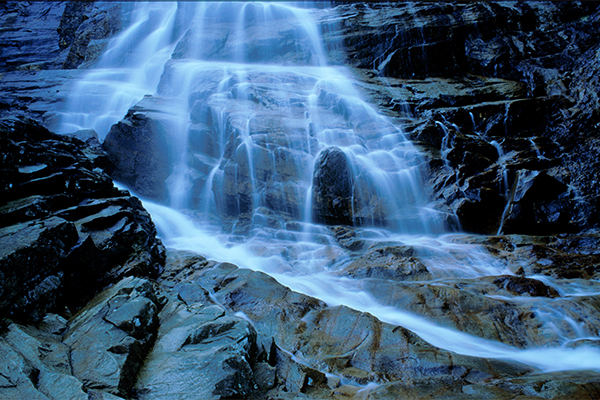 Arethusa Falls, New Hampshire NEUTRAL DENSITY FILTERSNeutral density filters (commonly called 'ND filters') can also extend your shutter speeds significantly, which helps create the blurred water look. These types of filters increase the amount of light required by your camera. ND filters come in a variety of density options, with some of the most popular options being 1-stop, 2-stops, 3-stops, 6-stops, and 10-stops. For waterfall photography, a 2-stop or 3-stop filter is perhaps going to be the most handy. I personally prefer a 3-stop ND filter, and I find that I am most commonly using shutter speeds with this filter in the 4 seconds to 15 seconds range. A warning when using neutral density filters: if there are windy conditions, tree branches and leaves can easily get blurred as a result of the long shutter speeds that end up being used. LENS CLEANERS & CLOTHSYou should always bring lens cleaner and a lens cloth with you on your waterfall shoots. The mist from many waterfalls is capable of spraying 10-2 0 feet or more. You'd be surprised how easily mist can find its way onto your lens (or lens filters) very, very quickly! Never try to wipe a lens clean with your fingers or a piece of clothing - you could easily scratch the lens or filter. Always use a lens cloth. BRACKETINGBracketing can be a waterfall photographer’s best friend. Every serious landscape photographer has a deep understanding of bracketing. Bracketing is the process by which you take several photographs of the same subject using different camera settings. In terms of waterfall photography, this typically means adjusting the aperture and/or shutter speed for either 3 or 5 different shots. You will most likely need to be in some sort of manual (like 'M' mode) or semi-manual mode (like 'AV' or 'TV' mode) on your DSLR camera in order to take advantage of bracketing. Some of the more advanced/expensive point-and-shoot cameras also offer bracketing. To illustrate bracketing, assume you want to use a shutter speed of 1/30 of a second because you want a long shutter speed to create a silky look for your waterfall. When you select this shutter speed, assume your camera's internal lighting meter suggests that you need to use f/8 as an aperture for proper exposure. In order to 'bracket', take one photo at the suggested shutter speed/aperture mix (1/30 of a second @ f/8), but also take two photographs on both ends of the metering spectrum (1/30 of a second at f/5.6 and 1/30 of a second at f/11, for example). When bracketing, you can modify either the shutter speed or the aperture. I recommend trying both to see which you like better. I also recommend bracketing both close and far from the proper exposure that your camera's meter is recommending (for example, if you are adamant about using 1/30 as a shutter speed, try shooting at all these apertures: f/8, f/11, f/13, f/16, etc.). This will result in pictures that range from way too dark to way too light. Hopefully one of the photographs in the middle of the range will be what you were hoping for in terms of exposure. You'll also want to remember that is generally better to go slightly under-exposed (too bright) than slightly over-exposed (too dark). The reason is because image quality is affected less when you darken photos later on using photo-editing software, as compared to when you brighten them. The reason is because of the details in the shadows; when you brighten-up shadows, you increase the "noise" in those areas, which results in a visible loss of image quality. If you use a film camera, bracketing can be a costly affair. Since film and developing costs are so expensive, you'll want to try to minimize bracketing. With a digital camera, the only cost of bracketing is of course the cost of file/data storage and backup. 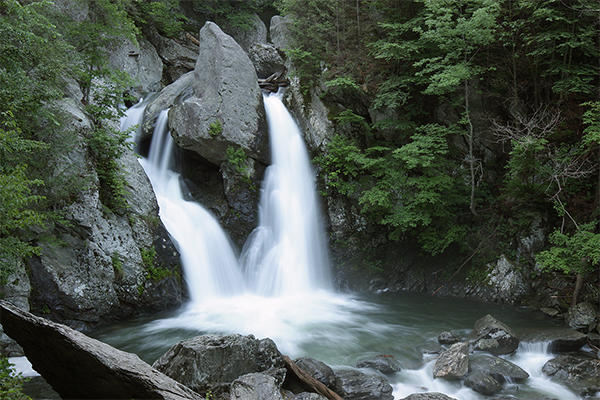 Bash Bish Falls, Massachusetts WHITE BALANCEMost digital cameras will allow you to modify or edit the "white balance" temperature in the JPEG files that your camera saves when you shoot. Modifying the white balance settings in your camera before you shoot can remove (or enhance) some of the blue, orange, or even green color tones in your photographs. The "manual" functions of your camera are typically where you will be able to change the white balance (in other words, the automatic picture modes usually don't let you edit this). I like to change this setting a few times at each scene to see what the results will be. Typically, a camera will have at least a "sunny", "shade" and "cloudy" mode. Try them all, even if you are not thinking the situation calls for it (for example, try the "shade" setting even though it is cloudy out). If you shoot in RAW mode (or RAW+JPEG), white balance can be completely adjusted or corrected later on during post-processing in photo editing software. The entire range of white balance can be adjusted if you shoot in RAW. However, many photographers will still spend time adjusting the white balance settings in their camera so that their JPEG files look their best. Here is an excellent source of information on white-balance if you want to learn more about this very important feature of your digital camera. FOREGROUND & COMPOSITIONBy making minor changes in the composition of your picture, you can turn an average shot into a professional one. Just try incorporating some natural features positioned around the waterfall into the photograph. Boulders in a streambed, hikers standing beside a waterfall, or wildflowers along the approach trail are three suggestions that can add another level of quality to your photos. You can also try shooting falls between trees or shooting from the top of a waterfall looking down. Finding foreground objects becomes necessary with waterfalls that have abnormally large pools at their base. Take the time to observe the entire landscape around the falls, searching for anything else that can help fill your camera's frame. This will enhance the quality of your pictures and more accurately reflect the actual size of the waterfall. Sometimes, you have to get dirty and/or wet in order to get the best shot! Spend time scouting locations when you arrive at the scene, but also do not forget about personal safety (be careful in the rivers and ravines - many photographers have been injured or killed at waterfalls). Many of my favorite shots were taken from angles that normally people do not usually seek (and in the process, I typically get wet). 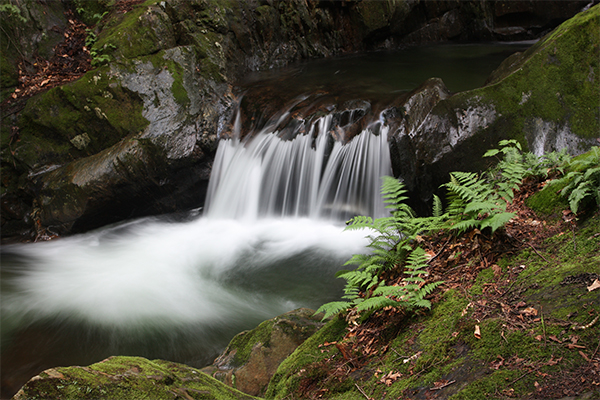 Honey Hollow Falls, Vermont DIGITAL ENHANCEMENTS / POST-PROCESSINGEvery serious photographer that I know uses some sort of photo-editing software to "post-process" their images. Products like Adobe Photoshop, Adobe Lightroom, and Adobe Photoshop Elements are the most popular post-processing software, but there are dozens of others. There is no denying that every picture can be improved in at least some way through post-processing, even if it is just a minor improvement. I personally try to minimize the amount that I manipulate my photographs. I believe in the natural beauty of places, and feel that landscape photographs should not be exaggerated with dramatic effects and colors. Here are the most common adjustments that I make to my RAW waterfall photographs in post-processing:
WEATHER & WATERFALL PHOTOGRAPHYMother Nature is very difficult to predict, but some facts are certain. The melting snow of early spring powers most waterfalls in New England well into June. After June, however, an understanding of the relationships among weather, waterfalls, and photography takes on great importance. You can expect the waterfalls throughout all of New England to be at some of their highest volumes of the year during spring. You are not likely to find the thin veils of water you may see during summer. In spring months you can expect to photograph chaotic crashes of whitewater at most falls. Some waterfalls are yet to be obstructed by tree leaves and other vegetation, which will begin to occur as summer rolls around. During summer, the greens of the trees and mosses surrounding the falls will add color to your pictures. Unfortunately, at many falls water flow is greatly reduced or even eliminated; photographs can look empty. Yet for some cataracts, this is the best time to compose a picture. Photos of waterfalls such as Bridal Veil Falls of New Hampshire and March Cataract Falls of Massachusetts radiate romantic feelings, as they capture thin veils of cascading water. A true waterfall photographer will also return during foliage and the winter season for new shots. If you want a typical postcard shot, capture the falls of northern New England during peak foliage. Two of the best waterfalls to shoot during this season are Arethusa Falls and Silver Cascade, both of New Hampshire. In a typical year, just about every color of fall-foliage is represented within yards of the falling water of these two falls. Peak fall foliage times for New England vary by state, with foliage usually near or at peak during the first two weeks of October for the northern states. The southern states often peak during the second and third weeks of October. Winter is the most difficult season to photograph in my opinion. The vibrant colors of spring and autumn are long gone, and your camera’s meter is often fooled by the reflecting white of the snow. You will find that many waterfalls are closed for the season simply because they are too dangerous to visit. If the falls are reachable, be sure to bracket your exposures over a greater range to ensure that at least one photograph meets your quality expectations. A circular polarizer can be very helpful to reduce glare during the snowy seasons. For any season, it is a good idea to carry a trash bag or waterproof dry bag in your backpack in case the weather turns bad. Cameras and lenses are easily damaged by water, and the combined protection of a backpack and a trash bag may save your equipment from the elements. Want more help with waterfall photography? There is a great book available on Amazon Kindle called How to Photograph Waterfalls like a Pro. Additionally, many, if not most, of the waterfall guidebooks currently on the market also have a chapter dedicated to waterfall photography. 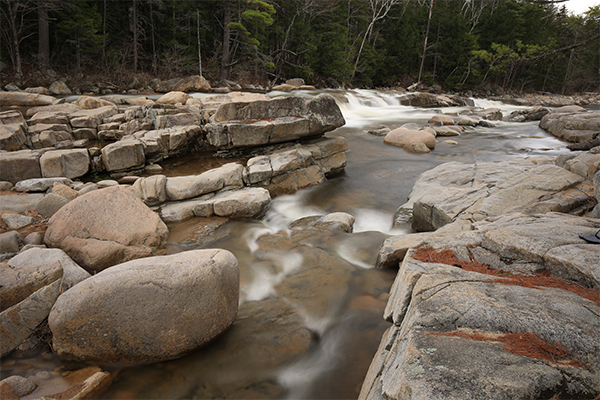 Lower Falls, Kancamagus Highway, New Hampshire TOP 10 WATERFALL PHOTOGRAPHY TIPSHere are my top ten waterfall photography tips. Learn these tips and you'll be well on your way to mastering waterfall photography.
I also recommend reading this list of 100 landscape photography tips > link NEXT STEPSWant to take your waterfall photography to a whole new level? Here are some tips for stepping it up a few notches:
Connecticut / Maine / Massachusetts / New Hampshire / Rhode Island / Vermont Home Page / About the Book / Book Updates / Top 40 Waterfalls / Swimming Holes / How To Use This Guide / Contact Us Waterfall Photography / Top 25 New England Hikes / 4000 Footers of NH / Bigroads.com © newenglandwaterfalls.com photographs/images may not be used without permission |
| Waterfalls, swimming holes, and hiking can be extremely dangerous. Hundreds of people have been injured or killed in the waterfalls and swimming holes of New England over the years. Never swim in strong water currents. Don't jump into a swimming hole without scouting it first. Do not climb up or along the side of waterfalls. Be wary of slippery rocks. Never swim in pools above waterfalls. Use of this website and all of its information is at your own risk! Newenglandwaterfalls.com will not be held liable for your actions. Be safe out there - and always use common sense! As an Amazon Associates affiliate, this website contains affiliate links. If you choose to purchase any products after clicking any links, I may receive a commission at no extra cost to you. I only endorse products that I have personally used or come highly recommended by trusted peers. |